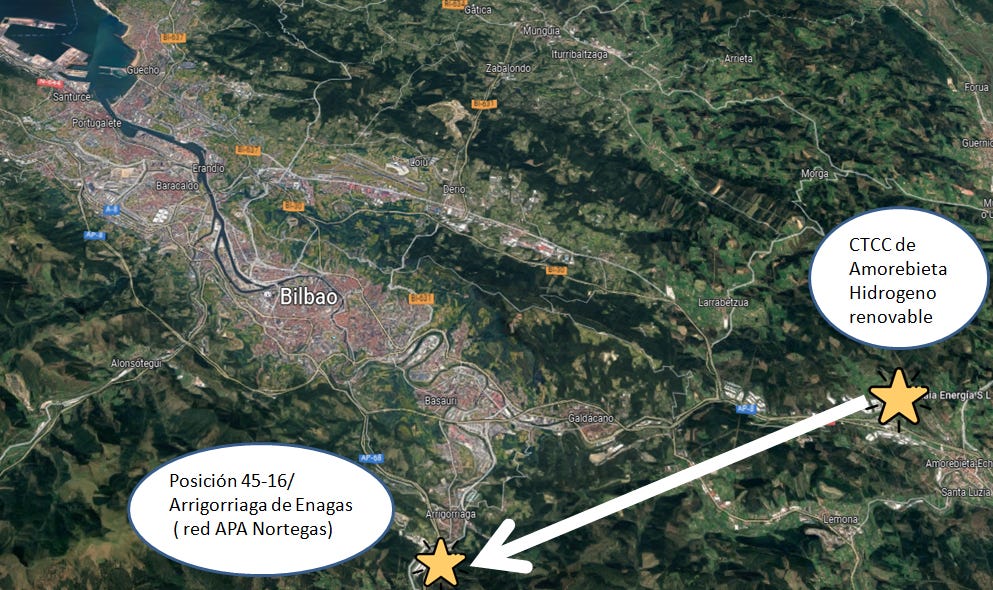19)Hidroducto más largo de la península ibérica (Proyecto Benorth2)
En la localidad vizcaína de Amorebieta se encuentra la planta de generación de electricidad en ciclo combinado (CTCC) que en 2023 comenzará a producir hidrógeno renovable, tras la medida pionera de descarbonización que propuso el consorcio formado por Nortegas, SENER, White Summit Capital, Castleton Commodities International y BIZKAIA ENERGIA SL.
Como pieza imprescindible del proyecto, está el hidroducto de 15.6km de longitud que se va construir para conectar las instalaciones de la CTCC de Amorebieta y la red de APA de gas natural localizada en la Posición 45-16/ Arrigorriaga de Enagas, donde parten los gaseoductos de la red APA (MOP 16 bar) de Nortegas, donde se inyectará el hidrógeno producido en la CTCC de Boroa.
Estación de Regulación y Medida, de cabecera estará situada en las inmediaciones de la instalacion de CTCC de Boroa, que garantizará la estabilidad en las condiciones de entrada del gas a la red de distribución de Nortegas: libre de impurezas (filtrado), presión máxima (regulación) y volumen vehiculado (medición).
Hidroducto, de acuerdo al código ASME B31.12, será API 5L Gr. B (con un diámetro mínimo de 8”).
Posición e Mezcla e Inyección (P.M.I.), al final del recorrido, que controle el porcentaje en volumen inyectado en la red de distribución de gas natural y la homogeneidad de la mezcla, así como garantizar que esté libre de impurezas (filtrado) y la medición del volumen inyectado. Inicialmente, la capacidad máxima de inyección de hidrogeno en la red de gas natural estará limitada a 5% del volumen de la mezcla de gases.
La máxima capacidad de generación de la instalación (Fase 1+ 2) será de 20MW, funcionando a potencia nominal de forma intermitente en las 2 siguientes franjas horarias:
1) 00:00 a 6:00 (por ser tarifa baja de compra) se producirán 300 kg H₂/h.
2) 10:00 a 18:00 (acuerdo bilateral de PPA Renovable) con un pico de 391Kg H₂/h.
En promedio la producción diaria será de 5,48T H₂ y el consumo diario se repartirá de la siguiente forma:
Uso combinado de Electrolizador y Almacenamiento (300bar) para asegurar una inyección constante a la turbina de 6:00 a 12:00 y de 18:00 a 00:00 de 80Kg/h (0,6% del consumo nominal del Gas Natural). Para ello se destinará diariamente 0,96 T H₂.
Inyección en Gaseoducto de 00:00 a 6:00 y de 10:00 a 18:00 (coincidente con el funcionamiento del electrolizador) de 300kg/h. Se verterán a la red por el hidroducto 4.38 T/día.
Suministro continúo de 23Kg H₂/h a la hidrogenera de 00:00 a 3:00 y de 12:00 a 15:00.
El hidroducto tiene un presupuesto de 5.189.250 € y tiene planificado un programa de trabajo de 24 semanas desde las catas iniciales a la puesta en marcha y llenado de la red.
19) Longest hydroduct in the Iberian Peninsula (Benorth2 Project)
The combined cycle power generation plant (CTCC) is located in the Biscayan town of Amorebieta, which will begin to produce renewable hydrogen in 2023, following the pioneering decarbonization measure proposed by the consortium formed by Nortegas, SENER, White Summit Capital, Castleton Commodities International and BIZKAIA ENERGIA SL.
An essential part of the project is the 15.6km long hydroduct that will be built to connect the Amorebieta CTCC facilities and the natural gas APA network located at Position 45-16/ Arrigorriaga de Enagas, where the gas pipelines of the APA network (MOP 16 bar) of Nortegas, where the hydrogen produced in the Boroa CTCC will be injected.
Regulation and Measurement Station, header will be located in the vicinity of the Boroa CTCC facility, which will guarantee stability in the conditions of gas input to the Nortegas distribution network: free of impurities (filtering), maximum pressure ( regulation) and vehicle volume (measurement).
Hydroduct, according to the ASME B31.12 code, will be API 5L Gr. B (with a minimum diameter of 8”).
Position of Mixture and Injection (P.M.I.), at the end of the route, which controls the volume percentage injected into the natural gas distribution network and the homogeneity of the mixture, as well as ensuring that it is free of impurities (filtered) and measuring of the injected volume. Initially, the maximum capacity for hydrogen injection into the natural gas network will be limited to 5% of the volume of the gas mixture.
The maximum generation capacity of the facility (Phase 1+ 2) will be 20MW, operating at nominal power intermittently in the following 2 time slots:
1) 00:00 to 6:00 (because it is a low purchase rate) 300 kg H₂/h will be produced.
2) 10:00 to 18:00 (bilateral Renewable PPA agreement) with a peak of 391Kg H₂/h.
On average, daily production will be 5.48T H₂ and daily consumption will be distributed as follows:
Combined use of Electrolyzer and Storage (300bar) to ensure a constant injection to the turbine from 6:00 to 12:00 and from 18:00 to 00:00 of 80Kg/h (0.6% of the nominal consumption of Natural Gas ). For this, 0.96 T H₂ will be allocated daily.
Gas pipeline injection from 00:00 to 06:00 and from 10:00 to 18:00 (coinciding with the operation of the electrolyser) of 300kg/h. 4.38 T/day will be poured into the network through the hydroduct.
Continuous supply of 23Kg H₂/h to the hydrogenerator from 00:00 to 3:00 and from 12:00 to 15:00.
The hydroduct has a budget of €5,189,250 and has a 24-week work program planned from the initial tastings to the commissioning and filling of the network.






